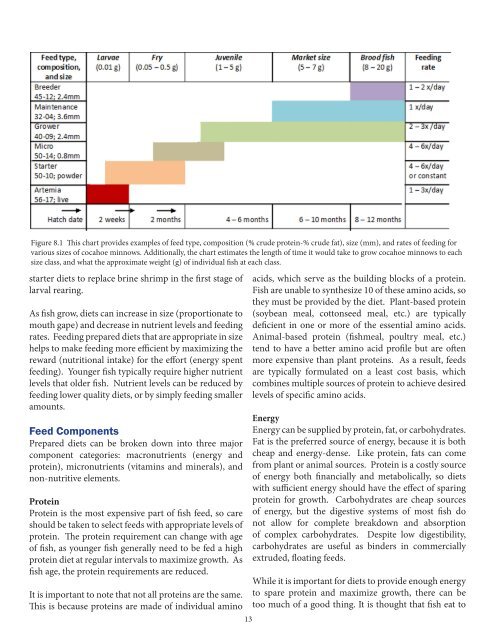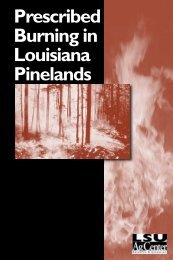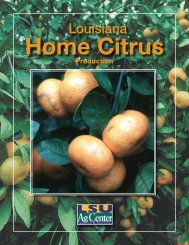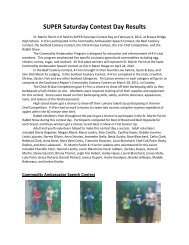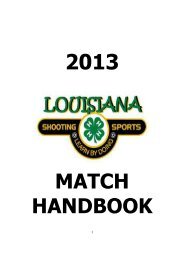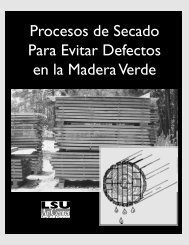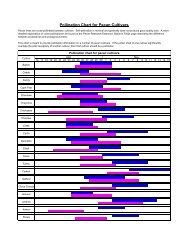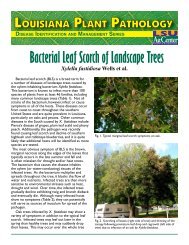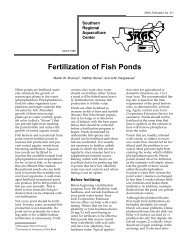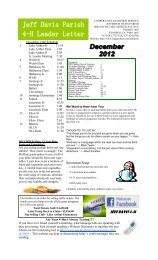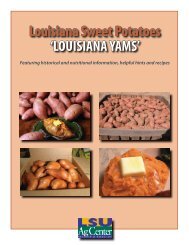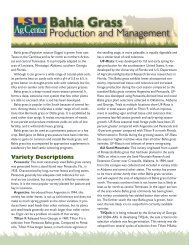Cocahoe Minnow - The LSU AgCenter
Cocahoe Minnow - The LSU AgCenter
Cocahoe Minnow - The LSU AgCenter
Create successful ePaper yourself
Turn your PDF publications into a flip-book with our unique Google optimized e-Paper software.
Figure 8.1 This chart provides examples of feed type, composition (% crude protein-% crude fat), size (mm), and rates of feeding for<br />
various sizes of cocahoe minnows. Additionally, the chart estimates the length of time it would take to grow cocahoe minnows to each<br />
size class, and what the approximate weight (g) of individual fish at each class.<br />
starter diets to replace brine shrimp in the first stage of<br />
larval rearing.<br />
As fish grow, diets can increase in size (proportionate to<br />
mouth gape) and decrease in nutrient levels and feeding<br />
rates. Feeding prepared diets that are appropriate in size<br />
helps to make feeding more efficient by maximizing the<br />
reward (nutritional intake) for the effort (energy spent<br />
feeding). Younger fish typically require higher nutrient<br />
levels that older fish. Nutrient levels can be reduced by<br />
feeding lower quality diets, or by simply feeding smaller<br />
amounts.<br />
Feed Components<br />
Prepared diets can be broken down into three major<br />
component categories: macronutrients (energy and<br />
protein), micronutrients (vitamins and minerals), and<br />
non-nutritive elements.<br />
Protein<br />
Protein is the most expensive part of fish feed, so care<br />
should be taken to select feeds with appropriate levels of<br />
protein. <strong>The</strong> protein requirement can change with age<br />
of fish, as younger fish generally need to be fed a high<br />
protein diet at regular intervals to maximize growth. As<br />
fish age, the protein requirements are reduced.<br />
It is important to note that not all proteins are the same.<br />
This is because proteins are made of individual amino<br />
13<br />
acids, which serve as the building blocks of a protein.<br />
Fish are unable to synthesize 10 of these amino acids, so<br />
they must be provided by the diet. Plant-based protein<br />
(soybean meal, cottonseed meal, etc.) are typically<br />
deficient in one or more of the essential amino acids.<br />
Animal-based protein (fishmeal, poultry meal, etc.)<br />
tend to have a better amino acid profile but are often<br />
more expensive than plant proteins. As a result, feeds<br />
are typically formulated on a least cost basis, which<br />
combines multiple sources of protein to achieve desired<br />
levels of specific amino acids.<br />
Energy<br />
Energy can be supplied by protein, fat, or carbohydrates.<br />
Fat is the preferred source of energy, because it is both<br />
cheap and energy-dense. Like protein, fats can come<br />
from plant or animal sources. Protein is a costly source<br />
of energy both financially and metabolically, so diets<br />
with sufficient energy should have the effect of sparing<br />
protein for growth. Carbohydrates are cheap sources<br />
of energy, but the digestive systems of most fish do<br />
not allow for complete breakdown and absorption<br />
of complex carbohydrates. Despite low digestibility,<br />
carbohydrates are useful as binders in commercially<br />
extruded, floating feeds.<br />
While it is important for diets to provide enough energy<br />
to spare protein and maximize growth, there can be<br />
too much of a good thing. It is thought that fish eat to


